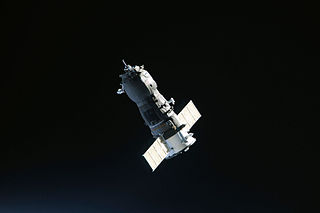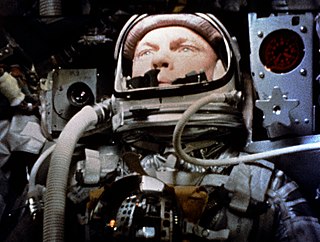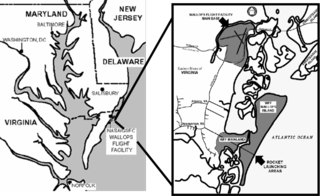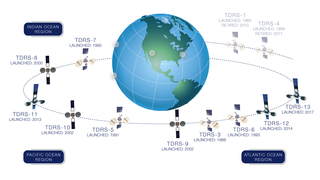
Project Mercury was the first human spaceflight program of the United States, running from 1958 through 1963. An early highlight of the Space Race, its goal was to put a man into Earth orbit and return him safely, ideally before the Soviet Union. Taken over from the US Air Force by the newly created civilian space agency NASA, it conducted 20 uncrewed developmental flights, and six successful flights by astronauts. The program, which took its name from Roman mythology, cost $2.38 billion. The astronauts were collectively known as the "Mercury Seven", and each spacecraft was given a name ending with a "7" by its pilot.
Syncom started as a 1961 NASA program for active geosynchronous communication satellites, all of which were developed and manufactured by the Space and Communications division of Hughes Aircraft Company. Syncom 2, launched in 1963, was the world's first geosynchronous communications satellite. Syncom 3, launched in 1964, was the world's first geostationary satellite.

Robotic spacecraft or uncrewed spacecraft are spacecraft without people on board. Uncrewed spacecraft may have varying levels of autonomy from human input; they may be remote controlled, remote guided or even autonomous, meaning they have a pre-programmed list of operations, which they will execute unless otherwise instructed. A robotic spacecraft designed to make scientific research measurements is often called a space probe or space observatory.

Mercury-Atlas 6 (MA-6) was the first crewed American orbital spaceflight, which took place on February 20, 1962. Piloted by astronaut John Glenn and operated by NASA as part of Project Mercury, it was the fifth human spaceflight, preceded by Soviet orbital flights Vostok 1 and 2 and American sub-orbital flights Mercury-Redstone 3 and 4.

Mercury-Atlas 8 (MA-8) was the fifth United States crewed space mission, part of NASA's Mercury program. Astronaut Walter M. Schirra Jr., orbited the Earth six times in the Sigma 7 spacecraft on October 3, 1962, in a nine-hour flight focused mainly on technical evaluation rather than on scientific experimentation. This was the longest U.S. crewed orbital flight yet achieved in the Space Race, though well behind the several-day record set by the Soviet Vostok 3 earlier in the year. It confirmed the Mercury spacecraft's durability ahead of the one-day Mercury-Atlas 9 mission that followed in 1963.

Mercury-Atlas 5 was an American spaceflight of the Mercury program. It was launched on November 29, 1961, with Enos, a chimpanzee, aboard. The craft orbited the Earth twice and splashed down about 200 miles (320 km) south of Bermuda, and Enos became the first primate from the United States and the third great ape to orbit the Earth.

The SAMOS or SAMOS-E program was a relatively short-lived series of reconnaissance satellites for the United States in the early 1960s, also used as a cover for the initial development of the KH-7 GAMBIT system. Reconnaissance was performed with film cameras and television surveillance from polar low Earth orbits with film canister returns and transmittals over the United States. SAMOS was first launched in 1960 from Vandenberg Air Force Base.

Mercury-Atlas 4 was an uncrewed spaceflight of the Mercury program. It was launched on September 13, 1961, at 14:09 UTC from Launch Complex 14 at Cape Canaveral, Florida. A Crewman Simulator instrument package was aboard. The craft orbited the Earth once.

Wallops Flight Facility (WFF) is a rocket launch site on Wallops Island on the Eastern Shore of Virginia, United States, just east of the Delmarva Peninsula and approximately 100 miles (160 km) north-northeast of Norfolk. The facility is operated by the Goddard Space Flight Center in Greenbelt, Maryland, and primarily serves to support science and exploration missions for NASA and other Federal agencies. WFF includes an extensively instrumented range to support launches of more than a dozen types of sounding rockets; small expendable suborbital and orbital rockets; high-altitude balloon flights carrying scientific instruments for atmospheric and astronomical research; and, using its Research Airport, flight tests of aeronautical research aircraft, including unmanned aerial vehicles.

The Scout family of rockets were American launch vehicles designed to place small satellites into orbit around the Earth. The Scout multistage rocket was the first orbital launch vehicle to be entirely composed of solid fuel stages. It was also the only vehicle of that type until the successful launch of the Japanese Lambda 4S in 1970.

A tracking and data relay satellite (TDRS) is a type of communications satellite that forms part of the Tracking and Data Relay Satellite System (TDRSS) used by NASA and other United States government agencies for communications to and from independent "User Platforms" such as satellites, balloons, aircraft, the International Space Station, and remote bases like the Amundsen-Scott South Pole Station. This system was designed to replace an existing worldwide network of ground stations that had supported all of NASA's crewed flight missions and uncrewed satellites in low-Earth orbits. The primary system design goal was to increase the amount of time that these spacecraft were in communication with the ground and improve the amount of data that could be transferred. These TDRSS satellites are all designed and built to be launched to and function in geosynchronous orbit, 35,786 km (22,236 mi) above the surface of the Earth.
The Manned Space Flight Network was a set of tracking stations built to support the American Mercury, Gemini, Apollo, and Skylab space programs.

This article incorporates public domain material from websites or documents of the National Aeronautics and Space Administration.

The Mars Orbiter Mission (MOM), also called Mangalyaan, was a space probe orbiting Mars since 24 September 2014. It was launched on 5 November 2013 by the Indian Space Research Organisation (ISRO). It was India's first interplanetary mission and it made ISRO the fourth space agency to achieve Mars orbit, after Roscosmos, NASA, and the European Space Agency. It made India the first Asian nation to reach the Martian orbit and the first nation in the world to do so on its maiden attempt.

A ground segment consists of all the ground-based elements of a space system used by operators and support personnel, as opposed to the space segment and user segment. The ground segment enables management of a spacecraft, and distribution of payload data and telemetry among interested parties on the ground. The primary elements of a ground segment are:
Kosmos 159, E-6LS No.111, was one of many satellites designed during the Soviet space program given the designation Kosmos. This satellite was specifically designed to be a high orbit satellite used to gain information on trajectory anomalies caused by the Moon's gravitational pull. This data would have been vital to the Soviet space program and could have been key in successful manned missions to the Moon. This mission was also used to test radio communications in space.

Progress MS-09, identified by NASA as Progress 70P, was a Progress spaceflight operated by Roscosmos to resupply the International Space Station (ISS). This was the 161st flight of a Progress spacecraft.

Progress MS-12, Russian production No.442, identified by NASA as Progress 73P, was a Progress spaceflight operated by Roscosmos to resupply the International Space Station (ISS). This was the 164th flight of a Progress spacecraft.

Explorer 22 was a small NASA ionospheric research satellite launched 9 October 1964, part of NASA's Explorer Program. It was instrumented with an electrostatic probe, four radio beacons for ionospheric research, a passive laser tracking reflector, and two radio beacons for Doppler navigation experiments. Its objective was to provide enhanced geodetic measurements of the Earth as well as data on the total electron content in the Earth's atmosphere and in the satellite's immediate vicinity.
Tianlian also known as CTDRS, is a Chinese data relay communication satellite constellation. The constellation serves to relay data from ground stations to spacecraft and rockets, most significantly China's crewed spaceflight program. The system currently consists of seven satellites in two generations, with the first satellite being launched in 2008.



















